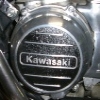Float Level Check Tool
- Patton
-

- Offline
- KZr Legend
-

Registered
- Posts: 18568
- Thanks: 2102
Re: Float Level Check Tool
24 Jan 2007 10:07
Good progress. Thanks for the report.
It's possible the float needle/seat is not completely closing when the float rises due to a speck of grit or other crud. Even with a perfectly adjusted float level, this condition could cause the float bowl to overflow with excess fuel passing out the overflow spigots. Another possibility would be a "leaking" float which would reduce the buoyancy of the float, or a "sticking" float. Or maybe the last person in there simply mis-adjusted the float tab. Seems there should be some logical reason for the float to evolve out of adjustment besides mere use and the passage of time.
But notwithstanding the above let's say after a good cleaning, the float level needs to be adjusted. Be careful and deliberate when bending the float tab because a minuscule change in the tab often results in a larger than expected difference in float level.
Checking the service float level is at this point with the freshly cleaned cars assembled and detached from the engine (probably on the work bench or an outside work table).
Might require several tiny precise tab bendings before finding the perfect float level, with each test requiring removal and replacement of the float bowl.
Here's a time and effort saving hint lifted from the chronicles of Wired George -- for testing purposes, only one of the four float bowl screws is sufficient to hold the float bowl in place (without needing the other screws).
Remember of course to replace all four float bowl screws on each carb before attaching the carbs to the engine.
It's possible the float needle/seat is not completely closing when the float rises due to a speck of grit or other crud. Even with a perfectly adjusted float level, this condition could cause the float bowl to overflow with excess fuel passing out the overflow spigots. Another possibility would be a "leaking" float which would reduce the buoyancy of the float, or a "sticking" float. Or maybe the last person in there simply mis-adjusted the float tab. Seems there should be some logical reason for the float to evolve out of adjustment besides mere use and the passage of time.
But notwithstanding the above let's say after a good cleaning, the float level needs to be adjusted. Be careful and deliberate when bending the float tab because a minuscule change in the tab often results in a larger than expected difference in float level.
Checking the service float level is at this point with the freshly cleaned cars assembled and detached from the engine (probably on the work bench or an outside work table).
Might require several tiny precise tab bendings before finding the perfect float level, with each test requiring removal and replacement of the float bowl.
Here's a time and effort saving hint lifted from the chronicles of Wired George -- for testing purposes, only one of the four float bowl screws is sufficient to hold the float bowl in place (without needing the other screws).
Remember of course to replace all four float bowl screws on each carb before attaching the carbs to the engine.
1973 Z1
KZ900 LTD
KZ900 LTD
The following user(s) said Thank You: GPz550D1
Please Log in or Create an account to join the conversation.
- JimatMilkyWay
-
- Offline
- User
-

Registered
- Posts: 285
- Thanks: 12
Re: Float Level Check Tool
24 Jan 2007 13:01
Patton wrote:
Good progress my left toe! Good progress would have been ripping down the road before midnight last night.Good progress. Thanks for the report....
I have only put 250 to 350 miles on it since I bought it and the guy who sold it to me only had it a few months. I think he bought it with the carbs freshly built and they appear super clean. I think they were just not set up quite right. The jets may be wrong as well, as he changed them.....It's possible the float needle/seat is not completely closing when the float rises due to a speck of grit or other crud. Even with a perfectly adjusted float level, this condition could cause the float bowl to overflow with excess fuel passing out the overflow spigots. Another possibility would be a "leaking" float which would reduce the buoyancy of the float, or a "sticking" float. Or maybe the last person in there simply mis-adjusted the float tab. Seems there should be some logical reason for the float to evolve out of adjustment besides mere use and the passage of time....
All good tips, especially the time saver about using one bowl screw to check level.....But notwithstanding the above let's say after a good cleaning, the float level needs to be adjusted. Be careful and deliberate when bending the float tab because a minuscule change in the tab often results in a larger than expected difference in float level.
Checking the service float level is at this point with the freshly cleaned cars assembled and detached from the engine (probably on the work bench or an outside work table).
Might require several tiny precise tab bendings before finding the perfect float level, with each test requiring removal and replacement of the float bowl.
Here's a time and effort saving hint lifted from the chronicles of Wired George -- for testing purposes, only one of the four float bowl screws is sufficient to hold the float bowl in place (without needing the other screws).
Remember of course to replace all four float bowl screws on each carb before attaching the carbs to the engine.
The following user(s) said Thank You: GPz550D1
Please Log in or Create an account to join the conversation.
- JimatMilkyWay
-
- Offline
- User
-

Registered
- Posts: 285
- Thanks: 12
Re: Float Level Check Tool
24 Jan 2007 13:04
Patton wrote:
Good progress my left toe! Good progress would have been ripping down the road before midnight last night.Good progress. Thanks for the report....
I have only put 250 to 350 miles on it since I bought it and the guy who sold it to me only had it a few months. I think he bought it with the carbs freshly built and they appear super clean. I think they were just not set up quite right. The jets may be wrong as well, as he changed them.....It's possible the float needle/seat is not completely closing when the float rises due to a speck of grit or other crud. Even with a perfectly adjusted float level, this condition could cause the float bowl to overflow with excess fuel passing out the overflow spigots. Another possibility would be a "leaking" float which would reduce the buoyancy of the float, or a "sticking" float. Or maybe the last person in there simply mis-adjusted the float tab. Seems there should be some logical reason for the float to evolve out of adjustment besides mere use and the passage of time....
All good tips, especially the time saver about using one bowl screw to check level.....But notwithstanding the above let's say after a good cleaning, the float level needs to be adjusted. Be careful and deliberate when bending the float tab because a minuscule change in the tab often results in a larger than expected difference in float level.
Checking the service float level is at this point with the freshly cleaned cars assembled and detached from the engine (probably on the work bench or an outside work table).
Might require several tiny precise tab bendings before finding the perfect float level, with each test requiring removal and replacement of the float bowl.
Here's a time and effort saving hint lifted from the chronicles of Wired George -- for testing purposes, only one of the four float bowl screws is sufficient to hold the float bowl in place (without needing the other screws).
Remember of course to replace all four float bowl screws on each carb before attaching the carbs to the engine.
Please Log in or Create an account to join the conversation.
- JimatMilkyWay
-
- Offline
- User
-

Registered
- Posts: 285
- Thanks: 12
Re: Float Level Check Tool
24 Jan 2007 13:04
Patton wrote:
I only had time to check the carb that I was sure leaked, but sure enough, the fuel level is exactly even with very top of float bowl, instead of 3 or 4mm below it.
The last thing I did before my beauty sleep was to run the overflow tubes from each carb into a separate cup to catch overflow fuel. Now, when I get home I will be able to check each one to see which has a problem.
If you do this procedure, be sure to put bike on center stand then chock/shim front wheel so bowl top is level.
I got 'er sealed off with _no_ leaks last night. Anyone who is interested, try this. I took a scrap, 20cm, or so piece of clear tubing that was 8mm OD, then put a fast taper on it using a dremmel with a 20mm or so (not critical) grind stone. Then, with only a half twist to thread it into drain port, it didn't leak, plus it held/holds itself stationary.At risk of stating the obvious, a few wraps of tape dope around the end of the clear plastic tube may tighten the fit....
I only had time to check the carb that I was sure leaked, but sure enough, the fuel level is exactly even with very top of float bowl, instead of 3 or 4mm below it.
The last thing I did before my beauty sleep was to run the overflow tubes from each carb into a separate cup to catch overflow fuel. Now, when I get home I will be able to check each one to see which has a problem.
If you do this procedure, be sure to put bike on center stand then chock/shim front wheel so bowl top is level.
Please Log in or Create an account to join the conversation.
- rckz
-
- Offline
- User
-

Registered
- Posts: 52
- Thanks: 0
Re: Float Level Check Tool
02 Mar 2007 06:09
Sounds simple enough. So what's
this thing
for?
Please Log in or Create an account to join the conversation.
- rckz
-
- Offline
- User
-

Registered
- Posts: 52
- Thanks: 0
Re: Float Level Check Tool
02 Mar 2007 06:09
Sounds simple enough. So what's
this thing
for?
Please Log in or Create an account to join the conversation.
- H1Vindicator
-

- Offline
- User
-

Registered
- Posts: 772
- Thanks: 122
Last edit: 21 Feb 2013 11:07 by H1Vindicator.
Please Log in or Create an account to join the conversation.
Moderators: Street Fighter LTD

